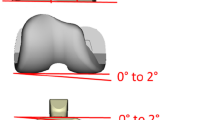Abstract
Purpose
Mosaic arthroplasty is a surgical technique in which a set of cylindrical osteochondral grafts is transplanted from non-load-bearing areas of the joint to repair damaged articular cartilage. Incongruity between the graft surface and the adjacent cartilage at the repair site results in inferior clinical outcomes. This paper compares technical outcome using three mosaic arthroplasty techniques (conventional, optoelectronic, and patient-specific template) on femur models.
Methods
Three distinct sets of femur models with defects were created. Preoperatively, the harvest and delivery sites were planned using custom software. Five orthopedic surgeons were recruited; each surgeon performed each of the three surgical techniques on each of the three bone models with defect. During the optoelectronic trials, the instrument position and orientation were tracked and superimposed onto the surgical plan. For the patient-specific template trials, plastic templates were manufactured to fit over the defects with cylindrical holes to guide the surgical tools according to the plan. Postoperatively, the femur models were computer tomography and laser scanned. Several measures were made to compare surgical techniques: operative time; surface congruency; defect coverage; graft surface area that is proud or recessed; air volume below the grafts; and distance and angle of the grafts from the surgical plan.
Results
The patient-specific template and optoelectronic techniques resulted in improved surface congruency, defect surface coverage, and below-graft air gap volume in comparison with the conventional technique. However, the conventional technique had a shorter operative time.
Conclusions
Image-guided techniques can improve the accuracy of mosaic arthroplasty, which could result in better clinical outcomes.





Similar content being viewed by others
References
Hasler EM, Herzog W, Wu ZJ, Müller W, Wyss U (1999) Articular cartilage biomechanics: theoretical models, material properties, and biosynthetic response. Crit Rev Biomed Eng 27(6):415–488
Gelber AC, Hochberg MC, Mead LA, Wang NY, Wigley FM, Klag MJ (2000) Joint injury in young adults and risk for subsequent knee and hip osteoarthritis. Ann Intern Med 133(5):321–328. doi:10.7326/0003-4819-133-5-200009050-00007
Imhoff AB, Ottl GM, Burkart A, Traub S (1999) Autologous osteochondral transplantation on various joints. Orthopade 28(1):33–44. doi:10.1007/PL00003547
Koh JL, Wirsing K, Lautenschlager E, Zhang LO (2004) The effect of graft height mismatch on contact pressure following osteochondral grafting: a biomechanical study. Am J Sports Med 32(2):317–320. doi:10.1177/0363546503261730
Pearce SG, Hurtig MB, Clarnette R, Kalra M, Cowan B, Miniaci A (2001) An investigation of 2 techniques for optimizing joint surface congruency using multiple cylindrical osteochondral autografts. Arthroscopy 17(1):50–55. doi:10.1053/jars.2001.19966
Jakob RP, Franz T, Gautier E, Mainil-Varlet P (2002) Autologous osteochondral grafting in the knee: indication, results, and reflections. Clin Orthop Relat Res 401:170–184. doi:10.1097/00003086-200208000-00020
Huang FS, Simonian PT, Norman AG, Clark JM (2004) Effects of small incongruities in a sheep model of osteochondral autografting. Am J Sports Med 32(8):1842–1848. doi:10.1177/0363546504264895
Kosel J, Giouroudi I, Scheffer C, Dillon E, Erasmus P (2010) Anatomical study of the radius and center of curvature of the distal femoral condyle. J Biomech Eng 132(9):091002-1–091002-6. doi:10.1115/1.4002061
Koulalis D, Di Benedetto P, Citak M, O’Loughlin P, Pearle AD, Kendoff DO (2009) Comparative study of navigated versus freehand osteochondral graft transplantation of the knee. Am J Sports Med 37(4):803–807. doi:10.1177/0363546508328111
Di Benedetto P, Citak M, Kendoff D, O’Loughlin PF, Suero EM, Pearle AD, Koulalis D (2012) Arthroscopic mosaicplasty for osteochondral lesions of the knee: computer-assisted navigation versus freehand technique. Arthroscopy 28(9):1290–1296. doi:10.1016/j.arthro.2012.02.013
Toyoshima T, Nagamune K, Araki D, Matsumoto T, Kubo S, Matsushita T, Kuroda R, Kurosaka M (2011) A development of navigation system for mosaic plasty using electromagnetic sensor. FUZZ-IEEE 2011 IEEE International Conference, pp 1447–1452, doi:10.1109/FUZZY.2011.6007593
Toyoshima T, Nagamune K, Araki D, Matsumoto T, Kubo S, Matsushita T, Kuroda R, Kurosaka M (2012) A development of navigation system with image segmentation in mosaicplasty of the knee. FUZZ-IEEE, 2012 IEEE International Conference, pp 1–6, doi:10.1109/FUZZ-IEEE.2012.6251338
Brzeczko AW, Goldberg RP, Taylor RH, Evans P (2001) Smart alignment tool for knee mosaicplasty surgery. In: medical image computing and computer-assisted intervention MICCAI 2001, vol 2208. Lecture notes in computer science. Springer, Berlin, pp 599–605. doi:10.1007/3-540-45468-3_72
Kunz M, Devlin SM, Hurtig MB, Waldman SD, Rudan JF, Bardana DD, Stewart AJ (2013) Image-guided techniques improve the short-term outcome of autologous osteochondral cartilage repair surgeries: an animal trial. Cartilage 4(2):153–164. doi:10.1177/1947603512470683
Kunz M, Waldman SD, Rudan JF, Bardana DD, Stewart AJ (2012) Computer-assisted mosaic arthroplasty using patient-specific instrument guides. Knee Surg Sports Traumatol Arthrosc 20(5):857–861. doi:10.1007/s00167-011-1638-2
Inoue J, Kunz M, Hurtig M, Waldman S, Stewart J (2011) Automated planning of computer assisted mosaic arthroplasty. In: medical image computing and computer-assisted intervention MICCAI 2011, vol 6891. Lecture notes in computer science. Springer, Berlin, pp 267–74. doi:10.1007/978-3-642-23623-5_34
Kunz M, Devlin S, Gong RH, Inoue J, Waldman SD, Hurtig M, Abolmaesumi P, Stewart J (2009) Prediction of the repair surface over cartilage defects: a comparison of three methods in a sheep model. In: medical image computing and computer-assisted intervention MICCAI 2009, vol 5761. Lecture notes in computer science. Springer, Berlin, pp 75–82. doi:10.1007/978-3-642-04268-3_10
Hangody L, Karpati Z (1994) A new surgical treatment of localized cartilaginous defects in the knee. Hung J Orthop Trauma 37:237–242
Tytherleigh-Strong G, Hurtig M, Miniaci A (2005) Intra-articular hyaluronan following autogenous osteochondral grafting of the knee. Arthroscopy 21(8):999–1005. doi:10.1016/j.arthro.2005.05.001
Acknowledgments
The authors are grateful to Paul St. John, HMRC (Human Mobility Research Centre, Kingston General Hospital, Kingston, Ontario, Canada) and all the participating surgeons and residents. This research was supported by Grant STPGP 385959 from the Natural Sciences and Engineering Council of Canada and Canadian Institute of Health Research.
Author information
Authors and Affiliations
Corresponding author
Ethics declarations
Conflict of interest
The authors confirm that there are no known conflict of interest associated with this publication.
Ethical standards
The study described in this manuscript was approved by the Queen’s University Health Sciences & Affiliated Teaching Hospitals Research Ethics Board. All participants provided their informed consent prior to their inclusion in the study.
Rights and permissions
About this article
Cite this article
Sebastyan, S., Kunz, M., Stewart, A.J. et al. Image-guided techniques improve accuracy of mosaic arthroplasty. Int J CARS 11, 261–269 (2016). https://doi.org/10.1007/s11548-015-1249-3
Received:
Accepted:
Published:
Issue Date:
DOI: https://doi.org/10.1007/s11548-015-1249-3




